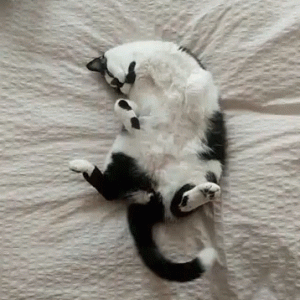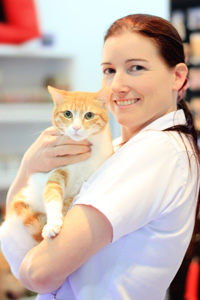September 17, 2020 by Dr. Sigrun Hackl
So after looking at a dogs way to communicate with us, how about cats?
They seem mysterious and independent, often misunderstood, aloof? Or outright ‘mean’?
Well, let me give you an example. My own cat, whom I considered rather dim, was giving me strange looks when I let her out one morning. Something seemed off, so I put on some shoes and grabbed my keys and stepped out to see what was going on. The cat started down the road, always looking back and checking that I was coming. Puzzled, but curious, I kept up with her until we reached a small alleyway between two houses. The cat’s expression changed as she halted this side of the passage, and slowly it dawned on me. I knew there was another cat living to one side of the alleyway, and frequently ‘guarding’ the passage. I went in to check for signs of the neighbor’s cat, then my own cat, reassured that the coast was clear, followed me cautiously, passed the alleyway, gave me a final look and jumped away, happy to be out. And I stood there in the alleyway realizing that I had just been recruited as a bodyguard. By my very own ‘dim’ cat.
Many cat owners will have had similar examples of how their cats communicated with them, masterly getting their humans to do what they want, and often enough without us realizing. But it’s not all about ‘being manipulated’, it’s much more about the art of silent and non verbal communication.


Cats do talk with their voices, but in most cases, that is mainly a means to draw our attention. Their moods are expressed with tails and ears. You had better beware of that twitching tip of the tail, it means trouble is imminent. Compare it with the annoyed drumming of the fingers of your angry boss who is restraining themself to not lash out in impatience. Ears folded back are a sign of anger or fear, and should equally be treated with caution. Referring to the cat, of course, not the boss.
While many cats will enjoy rolling on their back and presenting their belly, very few will actually enjoy being touched in this place. Do not mistake the cat’s casual relaxation with an invitation, or you may get a painful punishment!
Another ‘curiosity’ about cats is that they always appear to like people who dislike cats, but hide from those who love cats. Why is that?
Well, due to their small size, cats are cautious, always aware of their surroundings. In nature, they may well end up as someone’s dinner if they are not. They will, therefore, prefer a quiet and slow approach, checking and testing to make sure it is safe. They like hiding places and elevated spots for watching their environment from a safe distance. And they get easily intimidated when directly approached, especially by strangers. The direct look into the eyes is a severe threat in cat language, it is an aggressive move.
So while the cat lover is looking for the feline, trying to get in contact, the cat hater will usually ignore the animal and avoid any interaction. In the cat’s world, the cat lover is rude at best, and outright threatening at worst, while the cat hater is the most polite and gentle being in the world. So if you want to make friends with your friend’s cats, adopt the reserved approach.
A cat that wants to signal a peaceful mindset will show a very pronounced, slow blink, to give the direct look the opposite meaning. It is useful to mimic this habit, to always give a slow pronounced blink when looking directly at a cat, thus signaling your peaceful intentions. Do not go looking for the cat or follow her around, give her space and let her come to you on her own terms, and for sure, do not look her in the eyes. In other words, behave like you don’t care about cats, and they will often come to check you out very quickly!
If a cat has taken to you, it will generously show its affection – in the cat way. Rubbing their body along your legs means ‘we are family’, as it mixes the cat’s special scent from the glands located along its body with the scent of the human body. For cats, the world is all about scent. If you smell right, you belong. If you smell wrong, you need to leave!
Rubbing the chin on objects and furniture goes a step further, it is a marking for the most secure part of the cat’s territory, the ‘bedroom’ area, if you were to compare it with our human world. This is the true home and a sign of well-being and comfort.
And some cats will even treat their favourite human to a kitty kiss, which will be a gentle head bump in the kitten language, or a slight nose touch (nose to nose preferable) for adult cat language. Cats may maintain the ‘kitten vocabulary’ around their human family members. All these are true signs of affection.
Beware of play bites and nibbles. Some cats get carried away during cuddles and play time, especially male cats, as they like to play rough. They like to turn playful and grab or gently bite the human hand. While usually not intended to hurt, one has to be cautious, as any sudden move from the human in this situation can lead to painful scratches. It is, however, a move of affection and has good intentions from the feline side. To prevent your cat from getting carried away, it is best to stop interaction at this point and let him calm down a bit.
Some cats are very particular about the type and amount of human interaction they will tolerate, and since cat language is generally very subtle, many humans will find themselves suddenly and ‘viciously’ attacked mid-cuddle just because Miss Kitty (this is far more common in the female cats!) suddenly had enough of the attention and turned on the human. This behaviour is partly due to the cat’s nature of easily feeling threatened by larger species. They often have a degree of uncertainty or bias about the interaction and may not be 100% at ease with the touch. Furthermore, many of the warning signs that the cat may have given are often ignored or simply undetectable for our human senses.
Do watch for the twitchy tail again, as it may give you clues.
Unfortunately, we are simply deaf to certain sounds that the cats can make and we do not have the fine nose to understand olfactory messages. Know your cat’s character. This will help you read him/her better. But if in doubt, just always keep any interaction and cuddles very short and rather wait for the cat to ask for more, instead of risking that scratch of ‘It’s enough, Human!’.

Veterinary Surgeon

Be the first to know about exciting promotions, special discounts, and essential updates.
This website uses cookies to ensure you get the best experience on our website.